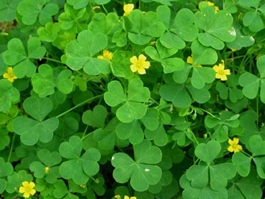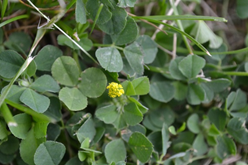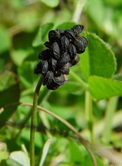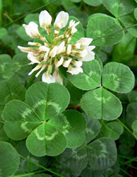Controlling Summer Broadleaf Weeds

During the summer, there are many broadleaf weeds in home lawns. Some look similar to each other and often times these weeds are confused with each other. What are broadleaf weeds? Broadleaf weeds are dicots characterized by their broad leaves and network of veins. Whichever weed your lawn has, broadleaf weed control can help get the results you desire.
Black Medic
 The black medic weed is often confused with clover and oxalis. While black medic, clover and oxalis all grow similarly and have common features, there are many differences that distinguish the three apart from each other.
The black medic weed is often confused with clover and oxalis. While black medic, clover and oxalis all grow similarly and have common features, there are many differences that distinguish the three apart from each other.
Black medic is found in mostly dry and compacted soils, it will grow along the edges of walkways, patios, driveways, etc., or in thin areas of the lawn. It germinates from seeds in the spring and grows throughout June, July and August. This weed can tolerate low mowing heights because of its (low, flat, stretched out) growing pattern, and it is able to grow out to 2 feet in length. While this weed does not fully root into the ground, it does have a very deep taproot that anchors it into the soil. Also, black medic weeds have the ability to make their own nitrogen, which is why they can outcompete turf in low nitrogen soils.
 The foliage has a trifoliate leaflet arrangement at the end of the stem, similar to clover and oxalis. The leaves have a mid-vein with pronounced rib-like veins running off vertically with a notch at the tip of the leaf. One distinguishing characteristic is that the leaf stem on the center leaf is slightly longer than on clover and oxalis. Black medic also produces small yellow flowers. Once the flowers get to maturity, they form tightly coiled black seedpods, hence the name “black medic”. Like many weeds that are problem some in the summer months, broadleaf weed control can be used to control black medic in your lawn.
The foliage has a trifoliate leaflet arrangement at the end of the stem, similar to clover and oxalis. The leaves have a mid-vein with pronounced rib-like veins running off vertically with a notch at the tip of the leaf. One distinguishing characteristic is that the leaf stem on the center leaf is slightly longer than on clover and oxalis. Black medic also produces small yellow flowers. Once the flowers get to maturity, they form tightly coiled black seedpods, hence the name “black medic”. Like many weeds that are problem some in the summer months, broadleaf weed control can be used to control black medic in your lawn.
White Clover
White clover begins to grow in the fall when the soil temperatures are between 50 and 60 degrees and remains present annually. Similarly to black medic, white clover is able to tolerate low mowing heights and can produce its own nitrogen making it thrive in low nitrogen soils and therefore out compete turf. White clover forms into a mat-like pattern, meaning the leaves are arranged in threes and occasionally fours (four leaf clover or the classic shamrock shape). Further, the leaves have a white ring towards the bottom of the leaf, which distinguishes it from black medic and oxalis. The root system is similar to
Further, the leaves have a white ring towards the bottom of the leaf, which distinguishes it from black medic and oxalis. The root system is similar to black medic in that it has a deep taproot and spreads by stolons. The flowers that are produced are white with a pink hue formed into a rounded head.

Oxalis
 The final summer weed to note is Oxalis. Oxalis can go by many names, but is commonly referred to as “woodsorrel” or “sourgrass”. Their leaves are made up of 3 heart shaped leaves that are attached to the top of a stem and the leaf color ranges from green to purple. Additionally, the oxalis weed produces a small 5 petal yellow flower at the end of its short stem. Under intense heat this weed’s foliage often reddens, wilts and turns downward towards the ground. The seeds germinate when air temperatures reach 60 to 80 degrees and have a similar root system to that of clover and black medic. The plant produces seed pods which can expel the seeds out to 10 feet in all directions. One seed pod can produce between 10-50 seeds and one plant can produce up to 5000 seeds per year.
The final summer weed to note is Oxalis. Oxalis can go by many names, but is commonly referred to as “woodsorrel” or “sourgrass”. Their leaves are made up of 3 heart shaped leaves that are attached to the top of a stem and the leaf color ranges from green to purple. Additionally, the oxalis weed produces a small 5 petal yellow flower at the end of its short stem. Under intense heat this weed’s foliage often reddens, wilts and turns downward towards the ground. The seeds germinate when air temperatures reach 60 to 80 degrees and have a similar root system to that of clover and black medic. The plant produces seed pods which can expel the seeds out to 10 feet in all directions. One seed pod can produce between 10-50 seeds and one plant can produce up to 5000 seeds per year.
Broadleaf Weed Control
There is a type of preventative treatment for broadleaf weeds; however it is cost prohibited in a residential lawn setting. To control these types of broadleaf weeds, a post-emergent herbicide is used, and there are many different herbicides to choose from. Be sure to follow the directions provided on the label about application.
Other ways to help control broadleaf weeds is through cultural practices. Proper watering, mowing and fertilizating helps keep the lawn vigorously growing and outcompeting the weeds.
Water deeply and infrequently to improve growth of the lawn. To start (underground irrigation systems) water your lawn 1 hour per zone twice per week. For hose-end sprinklers water 2 hours per zone twice per week. Water your lawn between midnight and 6 am. Avoid early evening watering. For a more in-depth description of watering properly, check out this blog article.
Mowing your lawn regularly at a reasonable height is another important practice. We recommend keeping the grass at 3-3 ½ inches in length and only taking 1/3 of the grass blade off at a time. Mowing below recommended grass height aids in depleting the grass of its energy reserves, and also thins the lawn’s canopy and encourages weed growth.
Regularly fertilizing your lawn helps stimulate the growth of the grass plants and outcompete the broadleaf weeds.
Also, regularly seeding bare or thin spots in the lawn will help keep those sections thick and dense to reduce weeds.
Conclusion
Even the best manicured and professionally maintained lawns eventually get some type of weeds. At the end of the day, all three of these weeds can be controlled with good cultural practices and herbicides. If you are unsure on how to treat these types of weeds on your own with a herbicide, choose a professional lawn care company to help. A professional lawn care company like Fairway Green Inc. has access to state-of-the-art tools, techniques and the best products available to produce the highest quality results.
If you are in our service area or have any questions about controlling broadleaf weeds, feel free to contact us at 908-281-7888 or visit our website at www.fairwaygreeninc.com




